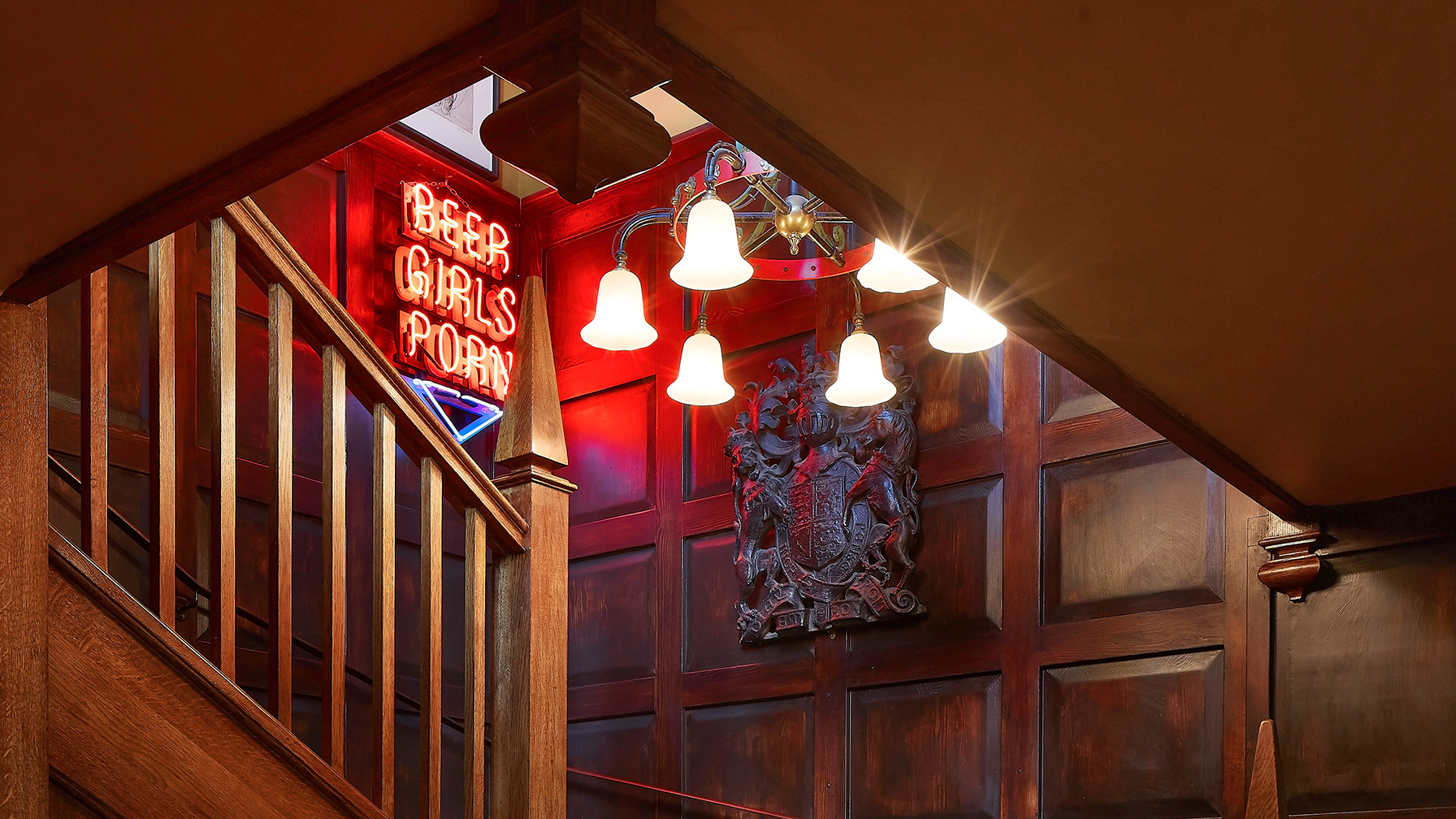
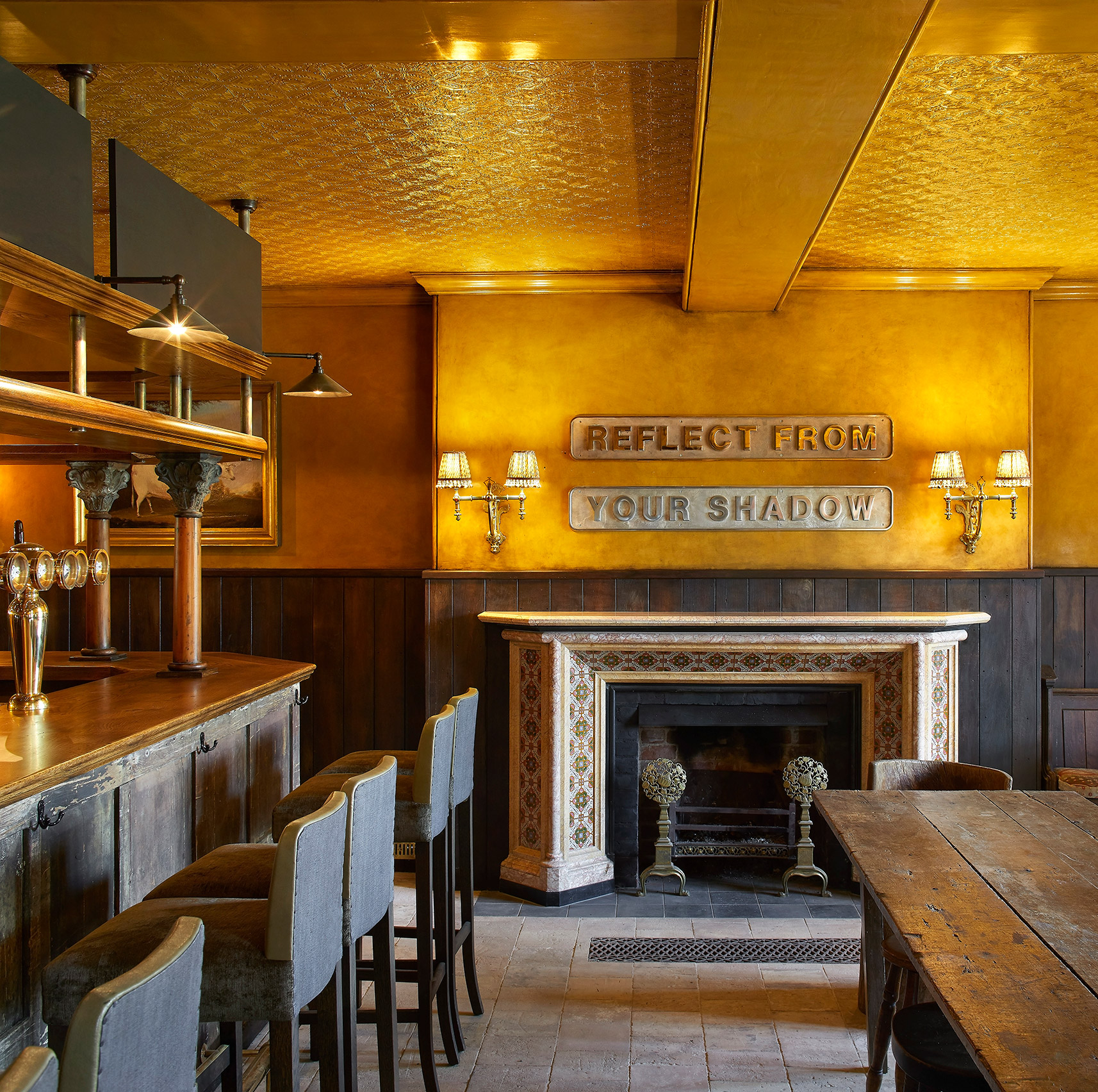
Main Bar
Over the fireplace is a sculpture by Darren Almond called ‘Waiting for You’ in the form of a steam locomotive name plate, a nod to the proximity of the railway line which runs next to the pub. The wording is enigmatic. According to Jungian psychology the ‘shadow’ is the side of your personality that contains all the parts of yourself that you don’t want to admit to having. Carl Jung saw it as the primitive side of our nature and believed we needed to see this dark side of ourselves if we were to be fully integrated human beings.
On each side of the fireplace there are pictures of prize cattle by 19th Century untrained painters. To the left of the bar is a moving image on an iPad by Rob and Nick Carter, above which is a satirical drawing of a theatre bar by Edward Burra, executed in the 1930’s. A German friend of mine, Arnd Kaestner, painted ‘The Clash’ in Coca Cola lettering and this is placed alongside a vintage framed Union Jack flag next to the TV. “I’m a bloody wreck: For the last year all I’ve done is drink”, on a newspaper cutting quoting Manchester United legend George Best is to the right on the same wall.
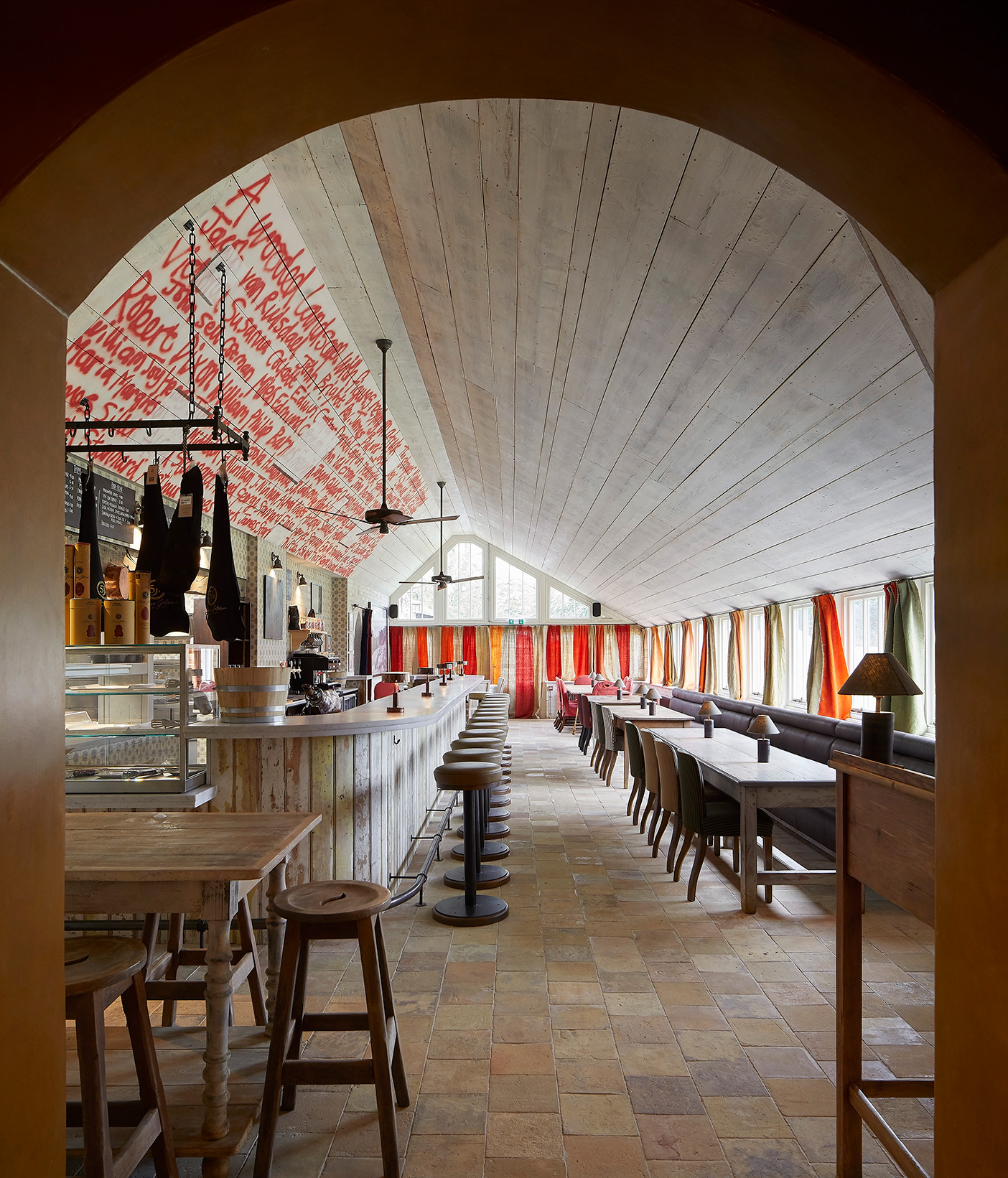
Tapas Bar and Greenhouse
Exiting the bar above the door is a word piece by Hank Willis Thomas. In the stairway hall is an 18th Century engraving depicting Sir Harbord Harbord, after a painting by Gainsborough. In contrast to the studied elegance of Baron Harbord is a painful scene at the dentist by an unknown painter on an adjacent wall.
Dominating the Tapas Bar, the ceiling painting is by Caragh Thuring, listing all the principal artists of the Norwich School. This was the first provincial art movement established in Britain, active in the early 19th Century. The artists were inspired by the Norfolk landscape and were influenced by the work of landscape painters of the Dutch Golden Age such as Hobbema and Ruisdael. The club was founded in 1803 by John Crome and Robert Ladbrooke and continued after Crome’s death in 1821 under the leadership of John Sell Cotman. The Norwich School’s great achievement was that a group of self-taught artists created a wonderfully original and vibrant body of work based on observation and love of landscape.
In particular, J. S. Cotman’s watercolours anticipate French Impressionism. The majority of their canvases were collected by the industrialist J. J. Colman (mustard manufacturer) andhave been on permanent display in Norwich Castle since the 1880’s. This lack of wider exposure is one reason why Norwich School artists are not as well known as other artists of the period, such as Constable and Turner. Caragh Thuring’s work is a tribute to these 19th Century artists. Caragh’s own lineage is partly Dutch, a connection with Holland shared by North Norfolk and, more specifically, by the Norwich School of Painters. Beneath the Thuring is a print by Glenn Ligon ‘With Hope’, a present to me from friends in what has been a uniquely testing year. Next to this is a small painting of a doughnut by American photorealist Ralph Goings. To the left of the gothic doorway are three pictures of birds and animals by children from the local primary school. And to the right there is a large photographic work of a reclining boy in a Brazilian landscape by Mauro Restiffe. To the left of the tapas bar is a sculpture of hummingbirds by Efrain Almeida, and under the TV is a bullfighting poster – given by Robin Birley, which reenforces the Hispanic feeling of the restaurant.
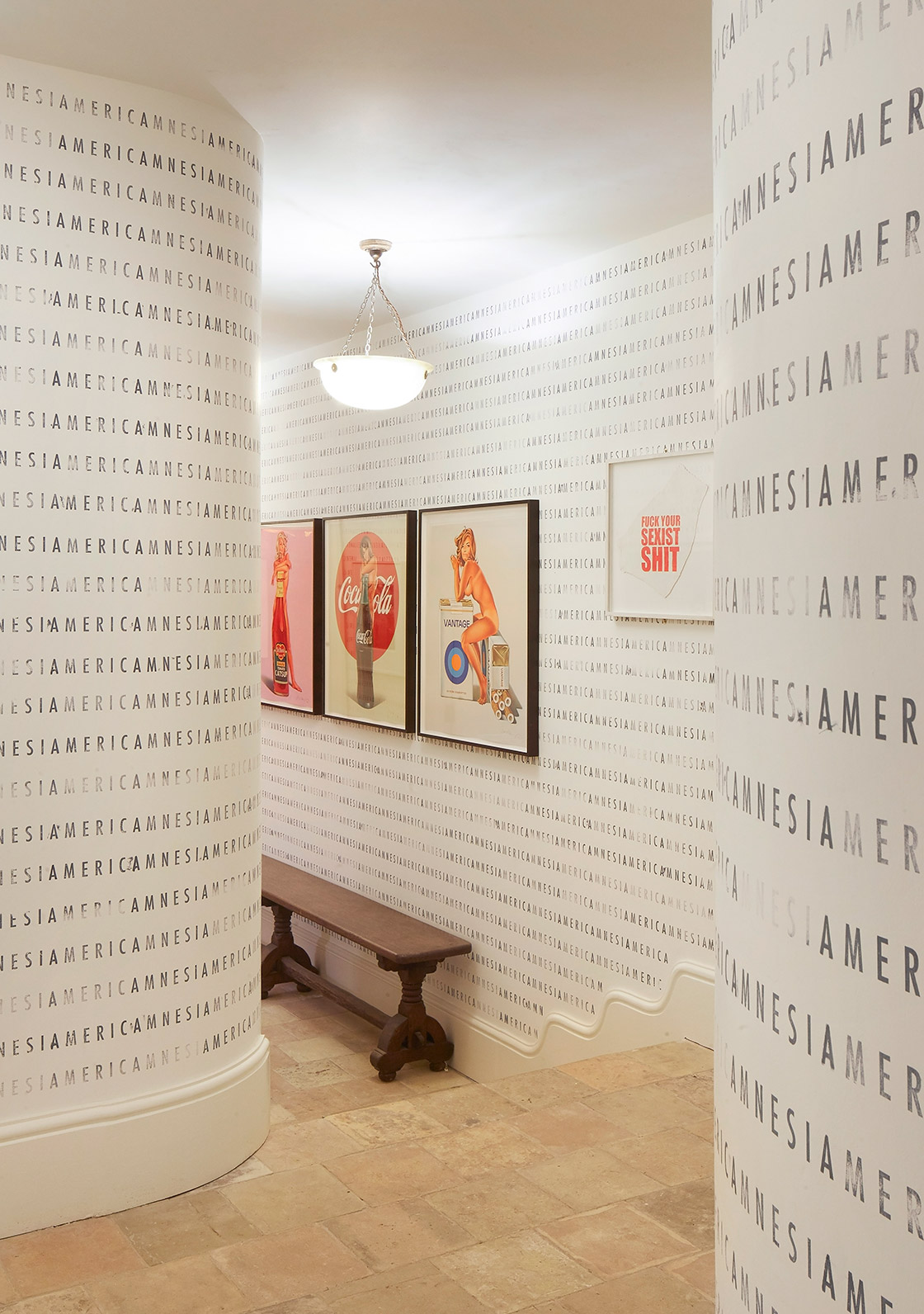
Corridor to WCs
The corridor is stencilled AMERICAMNESIA by Runo Lagomarsino, (executed by Ashley Thorp). Lagomarsino, who is based in Brazil, was born in Sweden to Argentine parents who descended from Italian emigres. His interest in the legacy of transatlantic migration intersects with his own biography. This particular work has the implication that US citizens think of ‘America’ as the U.S.A, forgetting that America was home to indigenous peoples and that the whole continent of South/Latin America exists and has a reality as valid as the America of the American Dream.
Coming into the corridor on the right is a portrait in pencil of Malcolm X by African American artist Charles Gaines. In Gaines’s view art need not be a subjective expression of the subjective ego. He puts forward the notion that rule-based formulations of ‘reality’, based on mathematical processes using systems, predominantly in the form of the grid (in dialogue with artists such as Sol Lewit), are equally valid. This questions the relationship between the objective and subjective realms and is a critique of the idea that art is product of the expressive, creative imagination. Gaines was born in Charleston and his early memories are of mystification at the imposed ‘Jim Crow’ laws segregating by race but through no apparent logic. In this drawing Gaines converts the head and features of the celebrated African-American activist Malcolm X into a systematized, pixelated form, imposing the neutrality of geometry on what could be a politically charged image. Malcolm X, born Malcolm Little, changed his name from that of slave-masters to “X”, symbolising the African family name that he could never Know.
To the left is Gerhard Richter’s ‘Oncle Rudi’, an officer on leave from the Luftwaffe in World War II. Turning the corner is a Tim Walker of my wife, Kristen McMenamy from a series of photographs taken at Gunton Park. This leads to a group of prints by Mel Ramos, an American artist who typically paints voluptuous female nudes lounging in martini glasses or astride spark plugs or coca cola bottles, marrying advertising with sexist overtones.
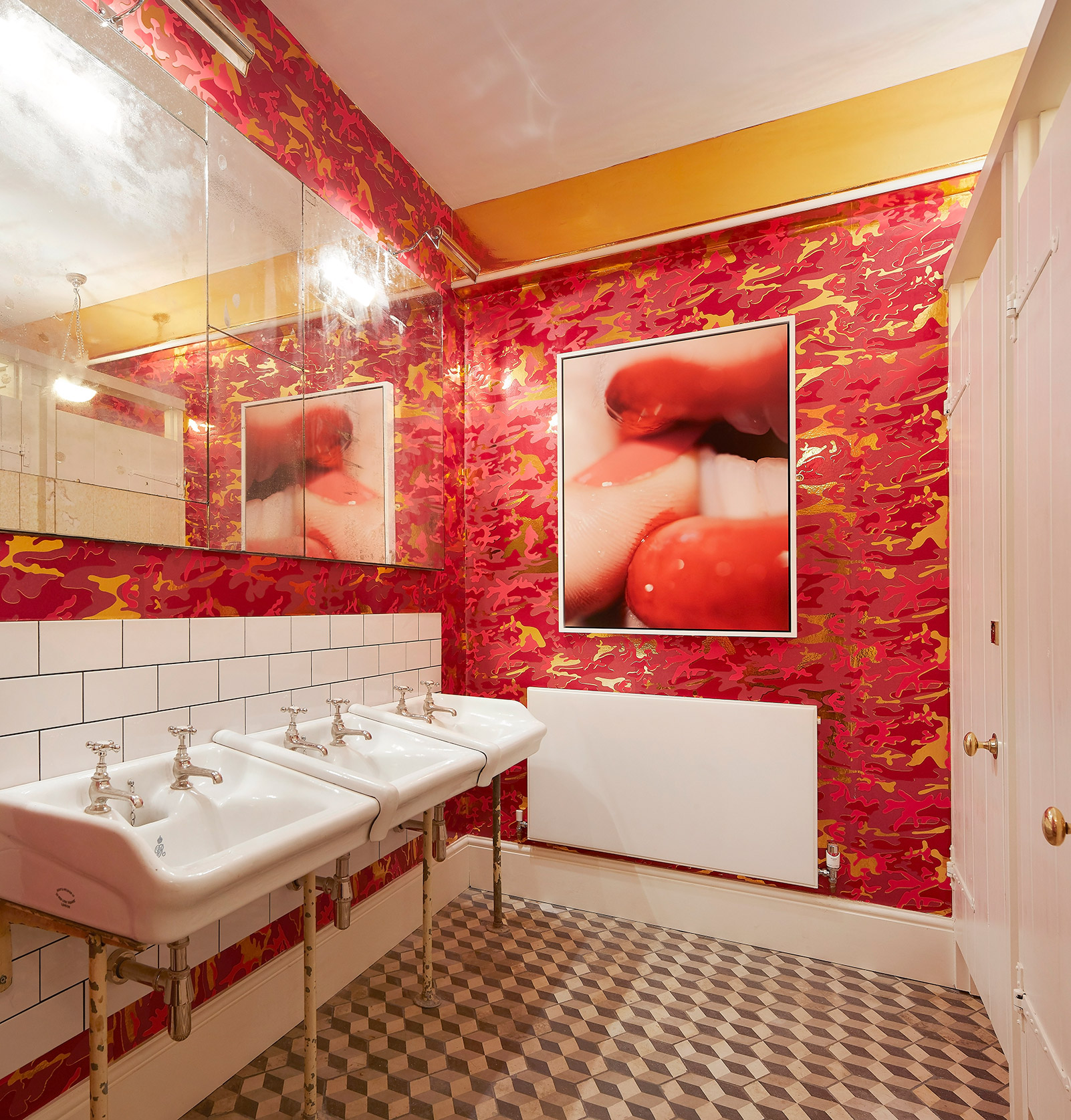
WCs
Counterbalancing the Ramos, on the same wall is Michael Landy’s ‘Fuck your Sexist Shit’. In the Men’s WC there are more photographs of Kristen McMenamy by Miles Aldridge, a poster of my hero, Iggy Pop and an Allen Jones ‘For Adult’s Only’ print. Between the Men’s and Women’s WC is a Diane Arbus photograph of strange psychological intensity, an uncanny image showing two young women in matching raincoats.
In the Women’s WC, contrasting with the male fantasy glossiness of Mel Ramos, there is a Robert Mapplethorpe of World Champion body builder Lisa Lyon. On the wall to the left are two photographs by Helmut Newton of supermodel Kristen McMenamy for Absolut Vodka commercials linked to major fashion designers John Galliano and Victor Alfaro for Vogue. On the opposite wall is a brilliantly coloured work by Marilyn Minter, a close up of nail-biting, ‘Nasty Habit’, and on another wall a fluorescently bright Jeremy Deller, ‘You treat this place like a hotel’. Inside the cubicles are botanical photographs by Mario Testino and a print by Bridget Riley.
The wallpapers in the WCs are by Andy Warhol for ‘Flavor Papers’. The Disabled WC has Warhol’s ‘Last Supper’ as a backdrop wallpaper. To the right is a pencil drawing by Bob Dylan, ‘Rural Route’, and on the left is a watercolour of Yasser Arafat by a Palestinian Israeli.

The Stairwell and Landing
Going upstairs is a neon work by Marcus Bracey, ‘BEER GIRLS PORN’ and, high up, the taxidermied head of a goat. Goats traditionally have been associated with the Devil and the Indian yellow background with the goat recalls the Satanic album cover of “Goat’s Head Soup” by The Rolling Stones. Within view of the goat is what at first sight appears to be an image of Christ, a self-portrait by Albrecht Dürer appropriated by Gilliam Wearing whose own eyes lurk behind the Dürer mask. A series of etchings by Glenn Brown based on Rembrandt line the wall at the top of the stairs.
The Magritte-like picture of doves in a forest makes us think of the soul leaving the body and is by the French artist Laurent Grasso. To the left of the outside terrace door is a small still-life by Mat Collishow.
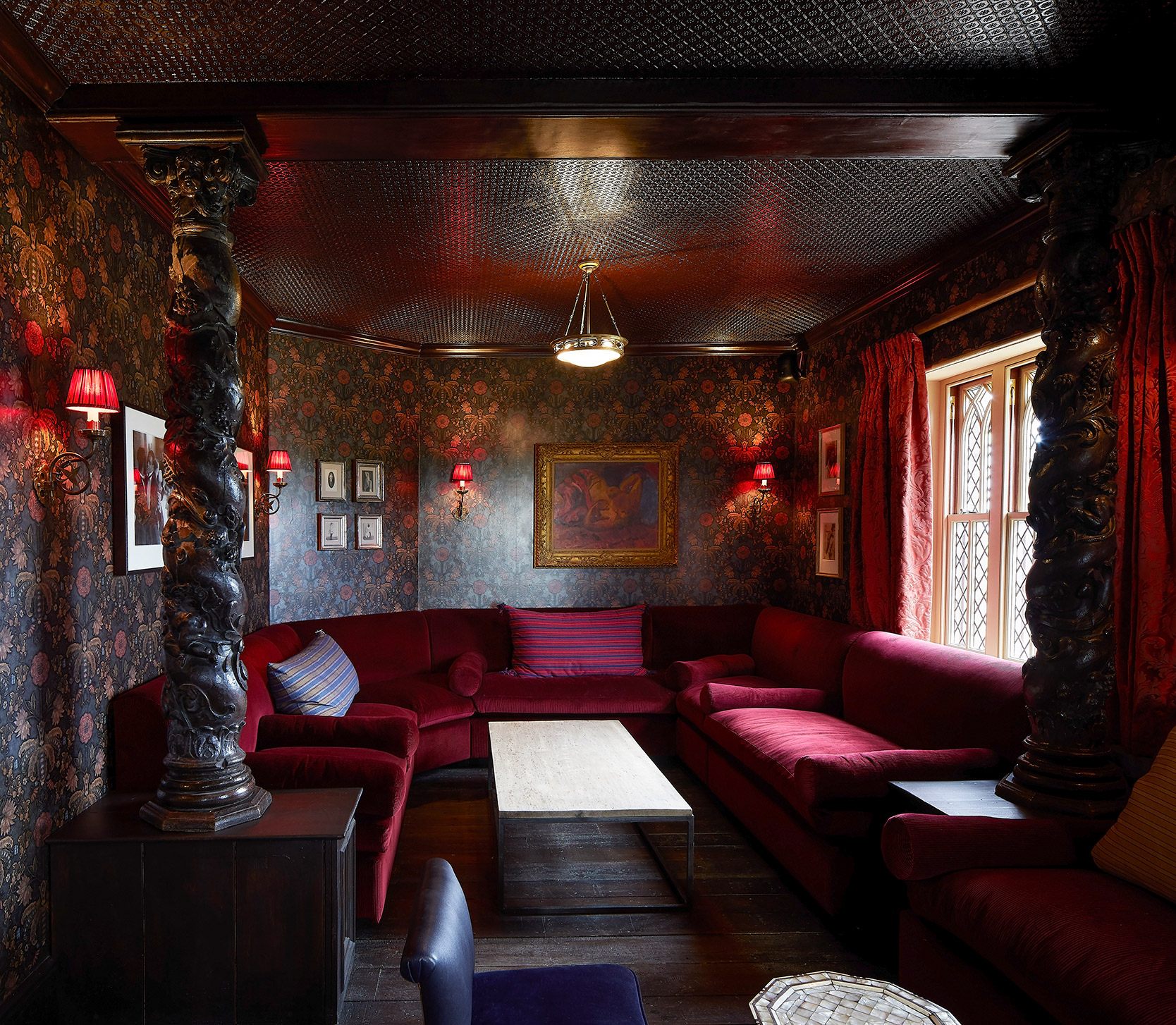
Saloon Bar
Inside the Saloon Bar facing the entrance are four prints by William Hogarth depicting ‘Stages of Cruelty’. Over the fireplace is another eerie landscape by Laurent Grasso which fuses quattrocento Florentine painting of a knight in a medieval landscape with a Magrittelike hovering rock.
The mirrors flanking the fire are convex and concave and suggest to me the antimonies of alchemy, linking with the world of Doctor Dee – Queen Elizabeth I’s physician and alchemist (who I think is the Mister D in the Jagger/Richards song “Dancing with Mister D” in the “Goat’s Head Soup” album) with rock music of the 1970s. They rhyme with the Darren Almond “Reflect from your shadow” in the Downstairs Bar: “As above, so below”, a dictum of Hermes Trismegistus (Thrice Great Hermes). His teachings, the “Hermetica” spanned many centuries, dating before Christ and links with the arcane writings of Zoroaster, Orpheus, Pythagoras, Plato and the divine knowledge of the Kaballah.
There are two more Glenn Brown etchings above the oak settle and next to them photographs from a shop in Savannah, which metamorphose from normality into horror a you walk past, and mirror the ambiguous faces of the neighbouring Glenn Brown prints.
At the end of the Saloon is a 1920s nude by Matthew Smith, with hot Rubenesque colours. Francis Bacon admired Smith and said he was the only English painter since Constable who had a natural affinity to oil paint and the ability to take risks and “splash the stuff down”. To the right of the Smith are two photographs by Baron von Gloeden of Sicilian boys taken in Taormina. Wilhelm von Gloeden is mostly known for his pastoral nude studies of Sicilian boys, featuring props suggesting a setting in Greece or Italy of antiquity. His work is homoerotic and also technically interesting owing to his controlled lighting, use of filters and special body make up (a mix of milk, olive oil, and glycerine) to disguise skin blemishes. Visited in Taormina by many, including Oscar Wilde, today he is mainly known for his nudes, but in his lifetime, he was also famous for his landscape photography that helped popularize tourism to Italy. In 1933, the Fascist police of Mussolini confiscated and destroyed thousands of prints and negatives from “Il Moro”, von Gloeden’s former lover aged 14. Much of von Gloeden’s work is now in museums in Italy and is also in the Metropolitan Museum in New York.
To the left are photographs by an American, William I. Goldman who documents scenes from a brothel in Reading, Pennsylvania in the 1890s. For their day, they have a detached objectivity and lack of salaciousness, a tribute to his respect and friendship with the girls. Goldman, who frequented the bordello of Sallie Shearer as a customer, kept the photographs for himself. These photographs might have remained out of the public domain forever if not for a friend of mine, Robert Flynn Johnson, a curator emeritus with the Fine Art Museums Achenbach Foundation for Graphic Arts, who stumbled onto part of the collection at a postcard fair in Concord in 2004. Robert telephoned me a year ago and I bought some of the series for the pub. This maybe the earliest photographic series ever done on American sex workers. Men could choose from a lineup of available women at Shearer’s bordello with authorities mostly looking the other way. Shearer was arrested at least once but Reading police were more alarmed by teenage boys’ use of the bordello and not by the prostitutes’ professional work with grown men. It was a time when Americans viewed prostitution as a safety valve for sexually active men who might attack respectable young women or for wandering husbands who strayed from their uninterested wives. How much Goldman exploited the women in Reading is open to debate. Certainly, Goldman’s photographs are in stark contrast to the salacious pornographic images that European photographers were taken around the same time in the 1890s.
To the left are two photographs by Isaac Julien of men in formal dress dancing in elegant surroundings.
En route to the WCs there is an iconic album cover made for the band Blind Faith that was for a time banned in America. ‘Blind Faith’ is the self-titled and only album by the English supergroup Blind Faith, released in 1969, where it topped the album charts in the UK, Canada, and the US. The band comprised Eric Clapton and Ginger Baker (both of ‘Cream’) working in collaboration with Steve Winwood (of the ‘Spencer Davis Group’ and ‘Traffic’) and Ric Grech. The album cover was a photograph by Bob Seidemann, a flatmate of Clapton’s, of a topless 11-year-old girl, Mariora Goschen, holding a silver painted model of an aircraft sculpted for the album shoot by Mick Milligan, a jeweller at the RCA. The cover was considered controversial, and the American record company issued it with an alternative cover. Seidemann explained his thinking: “To symbolize the achievement of human creativity and its expression through technology and a spaceship was the material object. To carry this new spore into the universe, innocence would be the ideal bearer, a young girl, a girl as young as Shakespeare’s Juliet. The spaceship would be the fruit of the tree of life… If she were too old it would be cheesecake, too young and it would be nothing”. Seidemann approached a girl on the London Underground about modelling for the cover but eventually used her radiantly innocent looking younger sister, who requested a horse for her fee but was instead paid £40.
Next to this image are two photographs by Larry Clarke of young Americans shooting up heroin. In the WC the wallpaper is Rorschach pattern wallpaper by Warhol . Psychologists used the Rorschach Test to examine a person’s personality characteristics and emotional functioning. It is thought to detect underlying thought disorder, especially in cases where patients are reluctant to describe their thinking processes openly. The test is named after its creator, Swiss psychologist Hermann Rorschach. In the 1960s, the Rorschach was the most widely used projected test, in which patients perceive objects, shapes, or scenery according to their individual experience.
The photographs “Flowers” are by Mat Collishow. Collishow disliked the sentimentally doctored images of flowers that appeared on greeting cards and calendars. He grafted animal skins onto various flowers by computer (‘Tiger Skin Lily’ and ‘Leopard Skin Lily’). The resulting images have an aggressive animal appearance which reflects the true nature of flowers as existing for almost solely procreation and as indifferent sexual predators. With their mutated, exotic forms they are like the freakish, diseased flowers cultivated by Des Esseintes, the hyper-sensitive protagonist of Huysmans great novel of the decadence, “À Rebours” (“Against Nature”).
